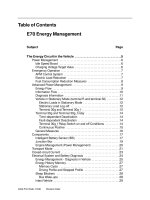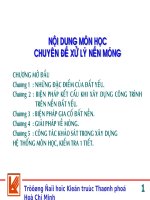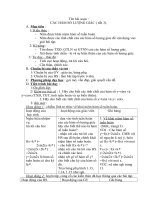C782 03
Bạn đang xem bản rút gọn của tài liệu. Xem và tải ngay bản đầy đủ của tài liệu tại đây (23.11 KB, 2 trang )
Designation: C 782 – 03
Standard Test Method for
Softness of Preformed Tape Sealants1
This standard is issued under the fixed designation C 782; the number immediately following the designation indicates the year of
original adoption or, in the case of revision, the year of last revision. A number in parentheses indicates the year of last reapproval. A
superscript epsilon (e) indicates an editorial change since the last revision or reapproval.
4. Summary of Test Method
4.1 The preformed tape sealant specimen is allowed to
equilibrate at standard conditions. A standard needle under a
defined load is placed on the specimen for 5 s. The penetration
of the needle into the preformed tape sealant is measured.
Multiple readings are recorded and averaged.
1. Scope
1.1 This test method describes a laboratory procedure for
determining the softness of preformed tape sealants.
NOTE 1—Cone penetration methods applicable to greases and to
petrolatum are described in Test Methods D 217 and D 937. Test Method
D 2451 also uses a penetration technique for determining the degree of set
in sash glazing compounds.
5. Significance and Use
5.1 Preformed tape sealants are tacky, deformable solids
that are used under compression between two substrates in a
variety of sealing applications. This procedure measures the
softness of a preformed tape sealant and gives an indication of
the preformed tape sealant’s ease of compression during
installation. The resistance to penetration may also give an
indication of the toughness of the preformed tape sealant.
1.2 The values stated in SI units are to be regarded as the
standard. The values given in parenthesis are for information
only.
1.3 The subcommittee with jurisdiction is not aware of any
similar ISO standard.
1.4 This standard does not purport to address all of the
safety concerns, if any, associated with its use. It is the
responsibility of the user of this standard to establish appropriate safety and health practices and determine the applicability of regulatory limitations prior to use.
6. Apparatus
6.1 Needle Penetrometer, as described in Test Method D 5,
with a certified needle.
2. Referenced Documents
2.1 ASTM Standards:
C 717 Terminology of Building Seals and Sealants2
D 5 Test Method for Penetration of Bituminous Materials3
D 217 Test Method for Cone Penetration of Lubricating
Grease4
D 937 Test Method for Cone Penetration of Petrolatum3
D 1321 Test Method for Needle Penetration of Petroleum
Waxes4
D 2451 Test Method for Degree of Set for Glazing Compounds on Metal Sash2
E 1 Specification for ASTM Thermometers5
NOTE 2—Test Method D 5 describes the needle method for determining
the penetration of bituminous material; Test Method D 1321 describes a
similar method for use with petroleum waxes, but a different needle is
used.
6.2 Stop Watch or Timing Mechanism, for the penetrometer.
6.3 Thermometer, to measure the temperature of the test
specimen in the vicinity of the temperature of the test. For tests
at 23 6 0.5°C (73 6 1°F) a thermometer conforming to the
requirements prescribed in Specification E 1 is recommended,
such as ASTM Saybolt Viscosity Thermometer 17C (or 17F)
having a range from 19 to 27°C (66 to 80°F).
7. Sampling
7.1 Samples to be tested shall be taken from a fresh roll of
preformed tape sealant, after first removing and discarding
approximately the first 600 mm (2 ft) of the roll.
7.2 Remove release paper as required in order to fashion a
suitable test specimen.
3. Terminology
3.1 Definitions—The definition of the following term used
in this test method is found in Terminology C 717: preformed
tape sealant.
1
This test method is under the jurisdiction of ASTM Committee C24 on Building
Seals and Sealants and is the direct responsibility of Subcommittee C24.20 on
General Sealant Standards.
Current editon approved May 10, 2003. Published June 2003. Originally
approved in 1986. Last previous edition approved in 1999 as C 782 – 99.
2
Annual Book of ASTM Standards, Vol 04.07.
3
Annual Book of ASTM Standards, Vol 04.03.
4
Annual Book of ASTM Standards, Vol 05.01.
5
Annual Book of ASTM Standards, Vol 14.03.
8. Test Specimen
8.1 Prepare a test specimen by cutting short lengths of
preformed tape sealant and plying them together to form a solid
block no smaller than 13 mm (0.5 in) wide by 13 mm (0.5 in)
by 25 mm (1.0 in) long.
Copyright © ASTM International, 100 Barr Harbor Drive, PO Box C700, West Conshohocken, PA 19428-2959, United States.
1
C 782 – 03
9. Conditioning
9.1 Condition the test specimen and the penetrometer,
including the needle, for at least 2 h at 23 6 2°C (73 6 3.6°F).
be made at points at least 7 mm (0.25 in.) from other readings.
The amount of penetration for each reading should be recorded
separately and the needle should be wiped clean after each
reading.
NOTE 3—Other test temperatures may be used, provided that the
specimen and the penetrometer, including the needle, are conditioned for
at least 2 h at such temperature and maintained at that temperature during
the test. For low temperature testing, for example, both conditioning and
testing must be done in a cold box.
NOTE 5—Unusually low readings, caused by the needle striking an
embedded core or other hard material, and unusually high readings caused
by penetrating a void or air pocket shall be considered invalid and
disregarded.
11. Report
11.1 Report the following information:
11.1.1 Identification of the preformed tape sealant, that is,
the name, lot number, and any other identifying characteristics.
11.1.2 Actual temperature of the test specimen and apparatus at the time of the test.
11.1.3 At least three valid penetration readings and their
average.
10. Procedure
10.1 Place the penetrometer in a level position with the shaft
set up so that there is a total moving load of 100 g. This load
is comprised of the 2.5-g needle, the 47.5-g shaft, and an extra
weight of 50 g placed atop the shaft.
10.2 Raise the penetrometer shaft until the pointer on the
dial reads exactly zero. Lightly tap the indicator dial control
lever to ensure that this reading is maintained.
10.3 Position the test specimen on the penetrometer so that
it is approximately centered under the needle. Then lower that
part of the apparatus consisting of the dial gage and shaft with
the needle point until the needle point just makes contact with
the top surface of the specimen.
12. Precision and Bias
12.1 Interlaboratory round-robin testing of the preformed
tape sealant softness has determined the 2s or 95 % confidence
level of precision for the needle penetrometer test of preformed
tape sealant softness at 23 6 0.5°C (73 6 1°F).
12.2 The single-operator-penetrometer-day precision is 0.3
mm.
12.3 The interlaboratory or multioperator precision is 1.0
mm.
NOTE 4—If the specimen is made from preformed tape sealant less than
13 mm (0.5 in.) wide, care should be taken to see that the needle is not
placed in the joint between two abutting strips of preformed tape sealant.
10.4 Quickly release the needle for 5 s.
10.5 Adjust the apparatus to measure the distance through
which the needle penetrated the specimen. Record the amount
of penetration to the nearest 0.1 mm.
10.6 Wipe the penetrometer needle clean. Following the
same procedure, take at least two additional penetration readings for the same preformed tape sealant specimen. If readings
are taken on the same specimen surface, the penetration should
NOTE 6—The single-operator and interlaboratory precision statements
for needle penetrometer testing of preformed tape sealant softness at 23°C
(73°F) have been found to hold for tests run at lower tape temperatures,
for example, −17.8°C (0°F). At elevated test temperatures, for example,
70°C (158°F) penetrometer readings and interlaboratory agreement is
somewhat less precise.
ASTM International takes no position respecting the validity of any patent rights asserted in connection with any item mentioned
in this standard. Users of this standard are expressly advised that determination of the validity of any such patent rights, and the risk
of infringement of such rights, are entirely their own responsibility.
This standard is subject to revision at any time by the responsible technical committee and must be reviewed every five years and
if not revised, either reapproved or withdrawn. Your comments are invited either for revision of this standard or for additional standards
and should be addressed to ASTM International Headquarters. Your comments will receive careful consideration at a meeting of the
responsible technical committee, which you may attend. If you feel that your comments have not received a fair hearing you should
make your views known to the ASTM Committee on Standards, at the address shown below.
This standard is copyrighted by ASTM International, 100 Barr Harbor Drive, PO Box C700, West Conshohocken, PA 19428-2959,
United States. Individual reprints (single or multiple copies) of this standard may be obtained by contacting ASTM at the above
address or at 610-832-9585 (phone), 610-832-9555 (fax), or (e-mail); or through the ASTM website
(www.astm.org).
2





![MAKE magazine [OH] 03](https://media.store123doc.com/images/document/13/ce/fj/medium_fjg1388298702.jpg)



